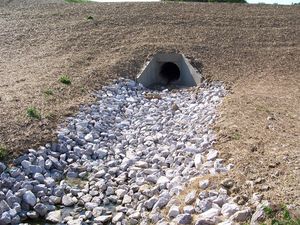
Difference between revisions of "Sediment control practices - Outlet energy dissipation"
| Line 33: | Line 33: | ||
Properly installed temporary and permanent energy dissipators are effective in preventing channel bank scour, slope gullying, and plunge pool erosion where concentrated flows discharge into unarmored, poorly stabilized areas. | Properly installed temporary and permanent energy dissipators are effective in preventing channel bank scour, slope gullying, and plunge pool erosion where concentrated flows discharge into unarmored, poorly stabilized areas. | ||
| + | [[Expected performance for outlet energy dissipators]] | ||
Revision as of 16:41, 18 October 2016
This page is under development. We anticipate populating it in autumn, 2016.
Contents
Outlet Energy Dissipation (Scour Protection)
Definition
Permanent or temporary energy dissipators prevent erosion, turbulence, and turbidity where stormwater pipes or ditches discharge to unprotected areas, such as channel banks, slopes, or upslope outfall locations. Their main purpose is to reduce the speed of concentrated flows to prevent scour at conveyance outlets. This practice is also called Scour Protection or Outlet Protection. Common types of outlet protection devices include concrete aprons, riprap-lined basins, and settling (stilling) basins.
Purpose and Function
Energy dissipators intercept incoming flows from pipes and ditches and deflect, scatter, or otherwise neutralize the erosive force of concentrated, moving stormwater. These structures are intended to protect soil from turbulence and high velocities, which can otherwise cause scour erosion. They typically consist of a structural apron lining fabricated from riprap, concrete, turf reinforcement mats, or other structural materials. Certain types of basins (e.g., settling/stilling/impact basins) can also function as energy dissipators. Many of these techniques are effective and relatively inexpensive and easy to install. Energy dissipators require careful design based on the hydraulic forces of concentrated flows exiting pipes and ditches.
Applicability
Energy dissipators at pipe and ditch outlets are appropriate for any unpaved or otherwise non-armored location where concentrated flows are discharged to areas subject to erosion.
Site Applicability
Energy dissipators are used where concentrated flows are discharged against channel banks, on poorly stabilized slopes, or onto upslope areas that are not protected against erosive flows. They are appropriate at the outlets of ponds, pipe slope drains, culverts, ditches, or other conveyances, and where runoff is conveyed to a natural or manmade drainage feature such as a stream, wetland, lake, or ditch. The most common applications include riprap aprons at culvert outlets, ditches lined with turf reinforcement matting, and stilling or impact basins designed to accept and dissipate high energy stormwater flows. Some important considerations when selecting energy dissipators for a site include:
- It may be difficult to remove sediment trapped by the dissipator without removing and replacing the structure.
- Rock/riprap outlets with high velocity flows require frequent maintenance.
- These BMPs may not be aesthetically pleasing.
Permit Applicability
Section III.C.3 of the 2013 MPCA Construction Stormwater General Permit requires energy dissipation at the outlet of temporary and wet sedimentation basins. Section IV.B.3 of the permit states that the permittee(s) “must use erosion controls and velocity dissipation devices such as check dams, sediment traps, riprap, or grouted riprap at outlets within and along the length of any constructed stormwater conveyance channel, and at any outlet, to provide a non‐erosive flow velocity, to minimize erosion of channels and their embankments, outlets, adjacent stream banks, slopes, and downstream waters during discharge conditions.”
Section IV.B.5 stipulates that “(p)ipe outlets must be provided with temporary or permanent energy dissipation within 24 hours after connection to a surface water,” and Section IV.B.6 requires permittee(s) to use “velocity dissipation devices if necessary to prevent erosion when directing stormwater to vegetated areas.” Discharge points from the dewatering of sediment basins must be “adequately protected from erosion and scour,” and “(t)he discharge must be dispersed over natural rock riprap, sand bags, plastic sheeting, or other accepted energy dissipation measures” (Section IV.D.1).
Effectiveness
Properly installed temporary and permanent energy dissipators are effective in preventing channel bank scour, slope gullying, and plunge pool erosion where concentrated flows discharge into unarmored, poorly stabilized areas. Expected performance for outlet energy dissipators
